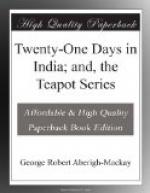Ali Baba’s practice of adequate payment, which he states—in a spirit of banter—to be potent to remove temptation to bribery and corruption, has received attention in connection with recent ameliorations of the terms of subordinate service in India, and it is believed has met with a certain amount of success.
The well-meant but not altogether satisfactory trial of the Gaikwar of Baroda, by a mixed tribunal of Indian Nobles and highly placed British officials, which took place during Lord Northbrook’s viceroyalty, is alluded to in the conclusion of the article; in which the Anglo-Indian soubriquet for a subservient person—Joe Hookham, literally jaisa hukam = as may be ordered—is also introduced.
No. 12
THE PLANTER
It is now upwards of thirty years since this genial picture of a veritable “Farmer Prince” was painted—in bold and broad outline, of course. The years that have passed bringing in their train many altered conditions, the most important of all, perhaps, being the replacing of a natural vegetable dye such as indigo by chemically produced substitutes.
Probably in a few more years the still remaining features of the Bengal indigo planter’s off duty life as depicted by Ali Baba will have quite disappeared, unless the substitution of sugar planting for that of indigo now receiving considerable attention in various Bengal, and more particularly Tirhoot, districts prove a success.
Anyway, the Macdonalds, the Beggs, and the Thomases, names now, as formerly, prominently identified with the great indigo industry, have been assured of continual remembrance. So prominent, in fact, has the Scotch element among planting families always been that it is said that if any one present at a race, polo, or Christmas week gathering were to shout out “Mac!” from the verandah of the Tirhoot Club, every face in the crowd would be simultaneously turned towards the speaker.
The bantering allusion to “Mr. Caird and The Nineteenth Century,” applies to that great authority on many and very varied agricultural subjects, the late Sir James Caird, who died in 1892. In 1878-79 he was deputed to India by the Secretary of State as a member of the Indian Famine Commission called into being by the Strachey Brothers; the general impressions then formed by a six months’ tour through India being embodied in the series of articles, entitled “Notes by the Way in India; the Land and the People,” which appeared from July to October, 1879, in The Nineteenth Century magazine, thereafter in book form in 1883, and in an augmented form as a third edition in 1884.
For a detailed account of a Bengal indigo planter’s life, mainly confined, however, to the processes and surroundings of planting and manufacture, there is no more valuable record than the late Colesworthy Grant’s well illustrated book, “Rural Life in Bengal,” which was published in 1860. In that work may be found a drawing of “Mulnath House,” a glorified illustration of the fast disappearing surroundings of a Lower Bengal planter’s residence.




